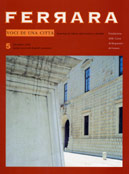On the twentieth anniversary of the prize, Gianni Granzotto wrote that in these books Ferrarese readers find «a key with which to understand the world, events great and small, unknown countries, the evolution of ideas, the transformations that follow one another before our very eyes: life, our life».
And that's why every crop of books entered for the prize contains the echo of the events of the previous year, together with testimony and reflection upon the development of human thought through progress, strife, fads, decadence, fanaticisms, absurdities, vices and virtues.
The shameful spectacle offered by the corruption of some literary prizes obliges me to say that another reason for the Premio Estense's eternal freshness is to be found in its total, absolute and irreprehensible independence, another congenital factor thanks to the characteristics imparted it by its first sponsor Giorgio Piacentini, who said: «We'll make it a reputable, independent prize, and we won't run the risk of its winding up with the awarding of the Aquila Estense to a journalist and a sequinned diadem to the local beauty queen».
Hence the independence of the members of the panel responsible for the submission of the short list of candidates to the people's panel made up of forty citizens of Ferrara - which has always been scrupulously safeguarded - and so sound is the reputation of this jury that the publishers involved have never tried to exert any pressure in an attempt to obtain preferential treatment.
Besides, the will of the Ferrarese panel represents an insuperable barrier, all the more so because the final debate before the assignation of the Aquila Estense is held in public every year and it makes fascinating listening as the readers defend the author chosen from the short list of four with an equal degree of enthusiasm and astuteness. And then, there is that particular amalgam that is the prize's birthplace: a prize like this could flourish only in Ferrara. The city is aristocratic and austere, but its citizens are expansive and hospitable to the point that the visitor is enthralled by its peerless atmosphere.
Which leads me to re-evoke, albeit briefly, those evenings when the winner was announced, when everybody would meet at Jolanda Piacentini's villa in Fossanova San Marco for a glittering, festive soirée, and I'm sure that older readers will be tempted to recall the Ballade des dames du temps jadis to repeat with nostalgia: "Mais ou sont les neiges d'antan?».
In 1985 we mourned the passing of Gianni Granzotto, our dear friend and indefatigable tutelary deity of the Premio Estense. In that year the local Industrialists' UNION decided TO offer a new prize TO be awarded alongside the Premio Estense.
The "Gianni Granzotto Award for Style in Information" consists OF a silver model OF the Regina - a twin-barrelled culverin FIRST CAST by order OF Duke Ercole II IN the Sixteenth century - TO be awarded every YEAR TO the living Italian personality working IN the field OF information, who had particularly distinguished him OR herself FOR integrity, commitment AND professionalism.
Its enormous prestige, which honours the memory OF Gianni Granzotto FOR his dedication TO the Prize, IS demonstrated by the NAMES that have won it since its inception: Indro Montanelli, Enrico Mattei, Alberto Ronchey, Eugenio Scalfari, Egisto Corradi, Enzo Biagi, Arrigo Levi, Baldassare Molossi, Geno Pampaloni, Ugo Stile, Enzo Bettiza, AND IN 1996, Piero Angela.
AND now, WITH the third millennium around the corner, it's up to Italian journalists to carry on deserving the esteem and goodwill of the folk of Ferrara as symbolized by the Aquila Estense and the Regina.



